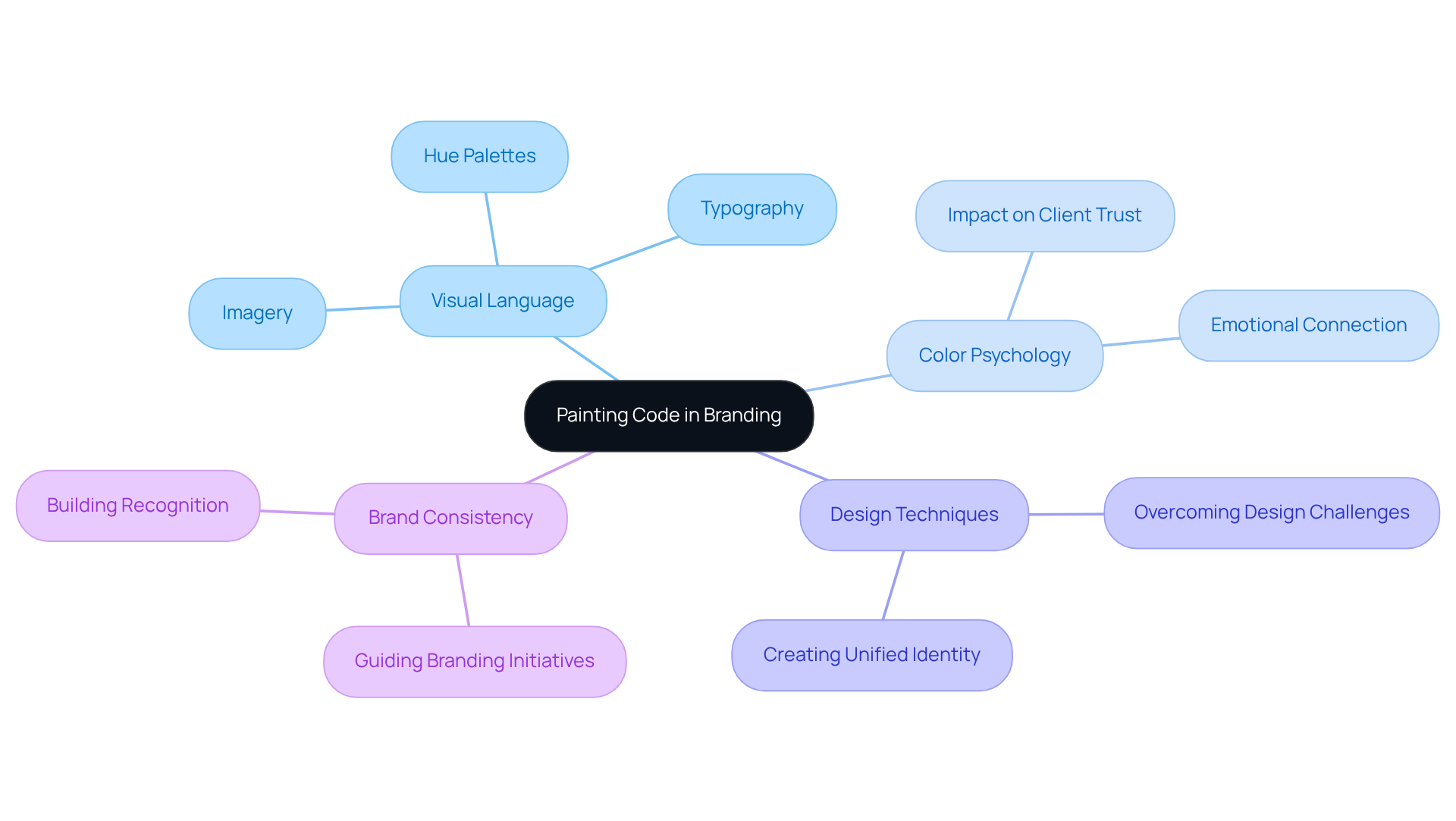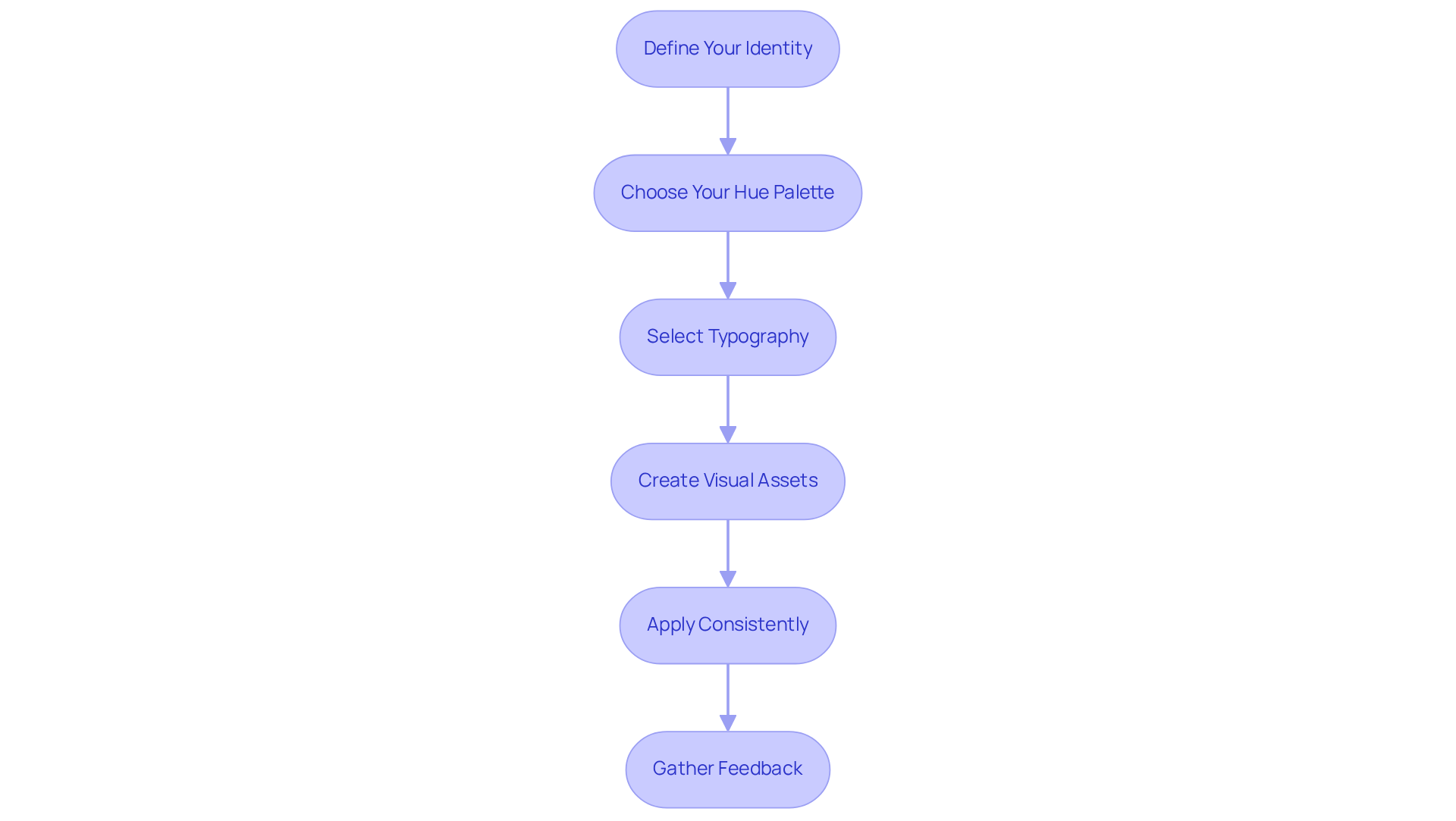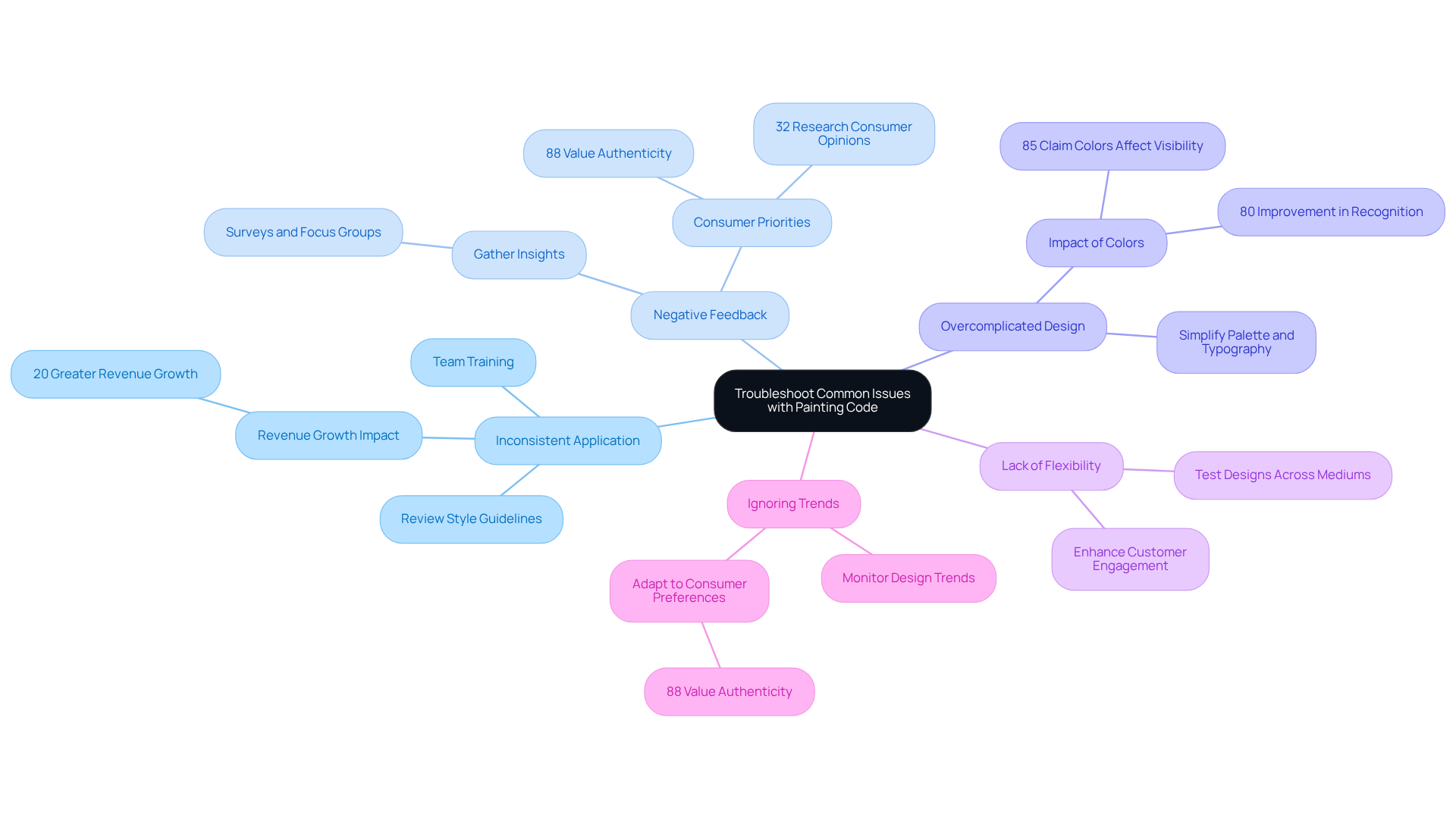Overview
In the world of tech startups, many founders grapple with the challenge of establishing a strong brand identity. This struggle often leads to feelings of uncertainty and frustration, especially when trying to connect with their audience. The reality is that mastering painting code—comprising visual language elements like color palettes, typography, and imagery—can feel overwhelming. Yet, it is essential for effective branding strategies. A well-defined painting code not only fosters brand consistency but also enhances recognition, which is crucial for building trust and driving business growth. Insights into color psychology highlight just how impactful these elements can be. By embracing cohesive design across platforms, founders can create a nurturing environment that resonates with their audience. Remember, you are not alone in this journey. Many have faced similar challenges and found success through understanding the importance of these visual elements. By focusing on mastering your painting code, you can transform your brand into a trusted and recognizable entity, paving the way for growth and connection.
Introduction
Establishing a tech startup can feel overwhelming, especially when it comes to carving out a unique identity. Many founders find themselves facing the daunting task of mastering the intricate elements of design, such as:
- Color palettes
- Typography
- Imagery
This is where the concept of painting code becomes essential. It encapsulates a brand's essence and serves as a cornerstone for effective branding strategies. Yet, the complexities can leave founders feeling lost and frustrated.
How can they overcome these challenges to create a cohesive and resonant brand identity? By exploring the nuances of painting code, startups can unlock the potential to forge deep connections with their audience and truly stand out in a crowded marketplace.
Remember, you are not alone in this journey; together, we can navigate these waters and build a brand that resonates with your vision.
Understand Painting Code and Its Role in Branding
In the journey of establishing a tech startup, painting syntax plays a crucial role. It encompasses the visual language and design components that express your organization's identity and values. This includes essential elements like hue palettes, typography, imagery, and overall aesthetic.
For many founders, mastering these design techniques can feel overwhelming, yet it is vital for creating a unified identity that resonates with your audience. Imagine a tech startup choosing a sleek, modern color scheme to convey innovation and sophistication, while a wellness company may opt for softer, earthy tones to evoke tranquility and a connection to nature.
By clearly defining your painting code, you establish a visual framework that guides all branding initiatives, ensuring consistency across platforms and touchpoints. This consistency is not just important; it is essential for building recognition and trust—key ingredients for long-term success.
As Steve Forbes wisely notes, a powerful identity is crucial for attracting and retaining clients, ultimately driving business growth. Understanding the influence of color psychology can significantly enhance , making it imperative for tech startups to leverage these insights in their marketing strategies.
At RNO1, we are dedicated to providing design-focused solutions that empower companies to effectively communicate their values through their color schemes. Our subscription models, including Revolve, Retrn, and Ryde, offer ongoing support, helping you maintain consistency in over time.
We understand the challenges tech startups face in establishing a strong digital presence, and we are here to enhance your marketability through Return On Design & Digital (RODD) strategies. Together, we can navigate these challenges and create a vibrant identity that truly reflects your mission.

Implement Painting Code in Your Branding Strategy
To effectively implement painting code in , you must consider the challenges that many tech startups encounter when establishing a strong identity. Without a clear brand, it’s easy to get lost in the competitive landscape, leaving potential customers unsure of who you are and what you stand for. Let’s explore how you can create a captivating brand identity that resonates with your audience.
- Define Your Identity: Start by articulating your organization’s mission, vision, and values. Think about the feelings you want your audience to experience when they engage with your brand. A clear identity is foundational for effective branding, providing a sense of direction and purpose.
- Choose Your Hue Palette: Selecting shades that resonate with your company’s personality and values is crucial. Research shows that hue can enhance product recognition by as much as 80 percent, based on a study from the University of Loyola, Maryland. For instance, blue often conveys trust and reliability, making it a popular choice among tech brands. Tools like Adobe Color can help you create harmonious palettes. Additionally, consider the cultural significance of colors, as they can carry different meanings in various contexts.
- Select Typography: The fonts you choose should align with your company’s tone. A modern sans-serif font may suggest innovation, while a serif font can evoke tradition and reliability. Consistency in typography strengthens your identity and helps your audience feel more connected to your brand.
- Create Visual Assets: Design logos, icons, and graphics that reflect your artistic style. Ensure these elements are versatile and adaptable across different platforms, enhancing recognition and appeal. For example, Wayfair’s consistent use of purple and turquoise has significantly contributed to their revenue growth, showcasing how visual consistency can lead to success.
- Apply Consistently: Implement your painting code across all branding materials, including your website, social media, and marketing collateral. Consistency is essential for strengthening your identity and ensuring that your audience can easily identify you. Old Spice’s unified hue strategy exemplifies how consistent application can enhance product recognition and drive sales.
- Gather Feedback: After implementation, it’s vital to solicit feedback from your audience to determine if your painting code resonates with them. Adjust your approach as necessary to align with their perceptions, ensuring your branding remains relevant and effective.
By following these steps, tech startups can establish a brand identity that stands out in a crowded market. Utilizing the psychological influence of hue and design can help cultivate deeper connections with your audience. As expert Kay La Belle notes, understanding the emotional responses elicited by different colors can significantly influence consumer choices. Remember, you’re not alone in this journey; many have faced similar challenges, and with the right strategies, you can create a brand that truly reflects your values and vision.

Troubleshoot Common Issues with Painting Code
When implementing painting code, several common issues may arise, and it's important to address them with care and understanding:
- Inconsistent Application: Many founders struggle with inconsistency in branding components across platforms, which can weaken identity recognition. This can be disheartening. To tackle this, we encourage you to review your style guidelines and ensure that your team is well-informed and adheres to the established standards. Remember, consistent companies experience over 20% greater revenue growth compared to inconsistent ones, which underscores the significance of this effort.
- If your audience provides negative feedback regarding your painting code, it's essential to gather insights through surveys or focus groups. This feedback is invaluable in refining your visual elements. After all, 88% of consumers prioritize authenticity in branding efforts, and 32% of customers investigate consumer views regarding a product before making a purchase. This highlights the necessity of listening to your audience, and we’re here to support you in that journey.
- Overcomplicated Design: Simplicity is crucial in branding, yet many designs can feel crowded. If yours does, consider simplifying your palette and typography. Aim for clarity and ease of recognition. Studies show that 85% of purchasers assert that hues greatly affect visibility and buying choices. A consistent brand color palette can improve brand recognition by up to 80%, so let’s work together to create something beautiful and effective.
- Lack of Flexibility: Your artwork script should be versatile enough to adapt across various mediums. Testing your designs on different devices and formats is essential to ensure they maintain their integrity. Brands that successfully adapt their visuals can enhance customer engagement and loyalty, reinforcing the importance of flexibility in design.
- Ignoring Trends: While consistency is vital, staying relevant is equally important. It’s essential to monitor design trends and be open to evolving your painting code in order to remain fresh and engaging. Brands that effectively communicate their story and adapt to consumer preferences can foster deeper emotional connections, leading to increased loyalty. Remember, 88% of customers value authenticity in branding, which ties into the need for brands to evolve with consumer preferences.
We understand these challenges can feel overwhelming, but you’re not alone. Together, we can navigate these issues and deeply with your audience.

Conclusion
Mastering painting code is vital for crafting a brand identity that truly resonates with your audience and builds trust. Many tech startups face the challenge of standing out in a crowded marketplace, and understanding the visual language of your brand—such as color palettes, typography, and imagery—can make all the difference. Establishing a cohesive identity is not just a creative task; it’s a crucial step in driving business growth and fostering customer loyalty.
Throughout this article, we’ve explored key strategies for effectively utilizing painting code in branding. These strategies include:
- Defining your brand identity
- Thoughtfully selecting color palettes and typography
- Consistently applying visual assets
- Being open to feedback and market trends
Each of these steps is designed to enhance brand recognition and forge an emotional connection with your audience, ultimately paving the way for greater success in your branding journey.
In closing, the importance of painting code in branding cannot be overstated. It serves as the cornerstone of your brand's visual identity and is a powerful tool for shaping consumer perception. By embracing these strategies and staying attuned to the ever-changing landscape, tech startups can cultivate a vibrant and authentic brand that not only stands out but also resonates deeply with their target audience. Now is the time to invest in mastering your painting code—your brand’s future truly depends on it.
Frequently Asked Questions
What is painting code in the context of branding?
Painting code refers to the visual language and design components that express an organization's identity and values, including hue palettes, typography, imagery, and overall aesthetic.
Why is mastering painting code important for tech startups?
Mastering painting code is vital for creating a unified identity that resonates with the audience, helping to establish consistency across branding initiatives, which builds recognition and trust.
How does color choice affect branding for different types of companies?
Different companies may choose color schemes that reflect their values; for example, a tech startup might use a sleek, modern color scheme to convey innovation, while a wellness company might opt for softer, earthy tones to evoke tranquility.
What role does consistency in painting code play in branding?
Consistency in painting code is essential for building recognition and trust, which are key ingredients for long-term business success.
How can understanding color psychology enhance a company's image?
Understanding color psychology can significantly improve a company's image by aligning the visual identity with the emotional responses of the target audience, making it imperative for effective marketing strategies.
What services does RNO1 offer to help companies with their design and branding?
RNO1 provides design-focused solutions and subscription models, such as Revolve, Retrn, and Ryde, which offer ongoing support to help companies maintain consistency in their design systems over time.
What challenges do tech startups face in establishing a strong digital presence?
Tech startups often face challenges in creating a vibrant identity that reflects their mission and effectively communicates their values, which RNO1 aims to address through their Return On Design & Digital (RODD) strategies.




